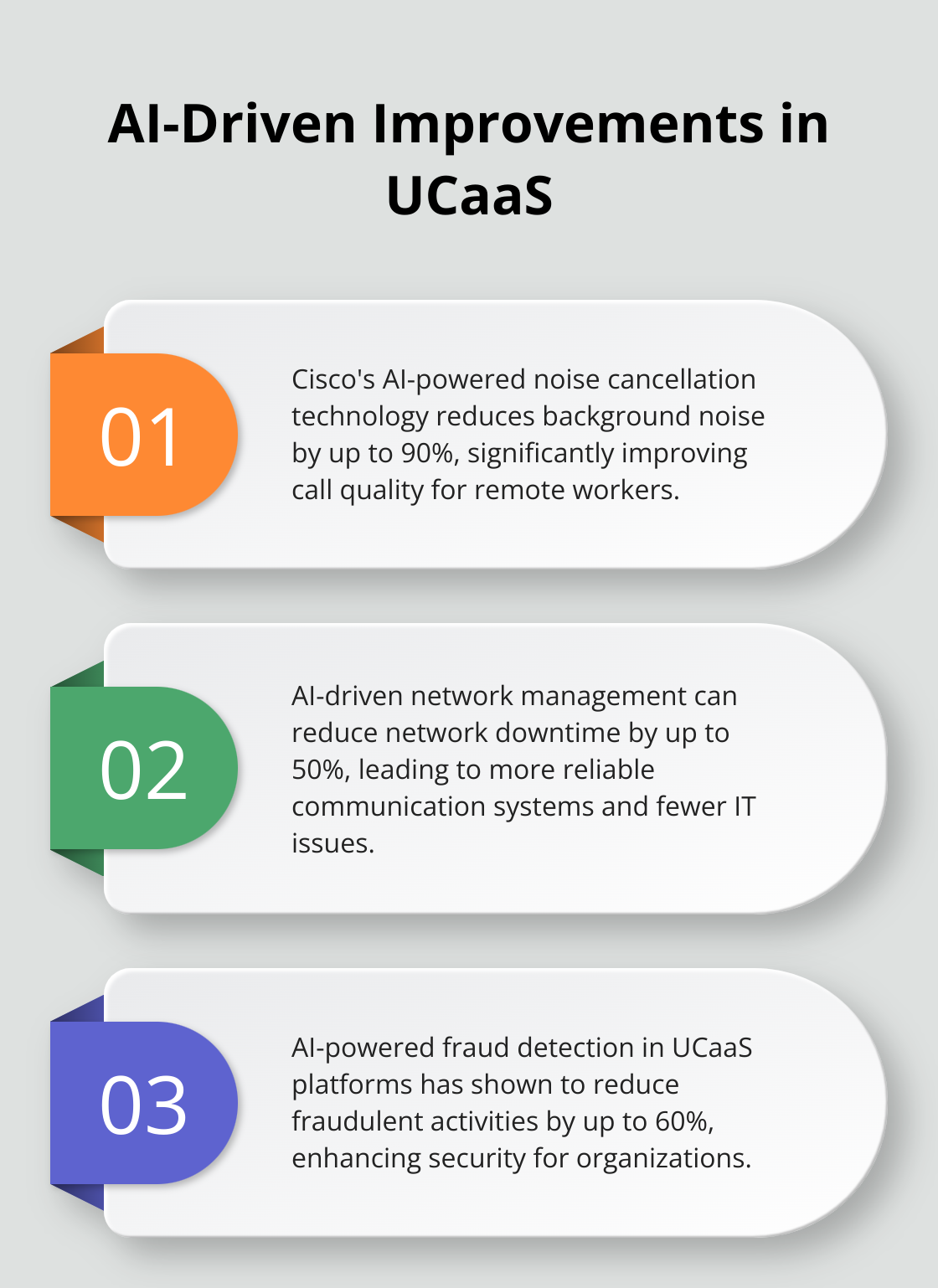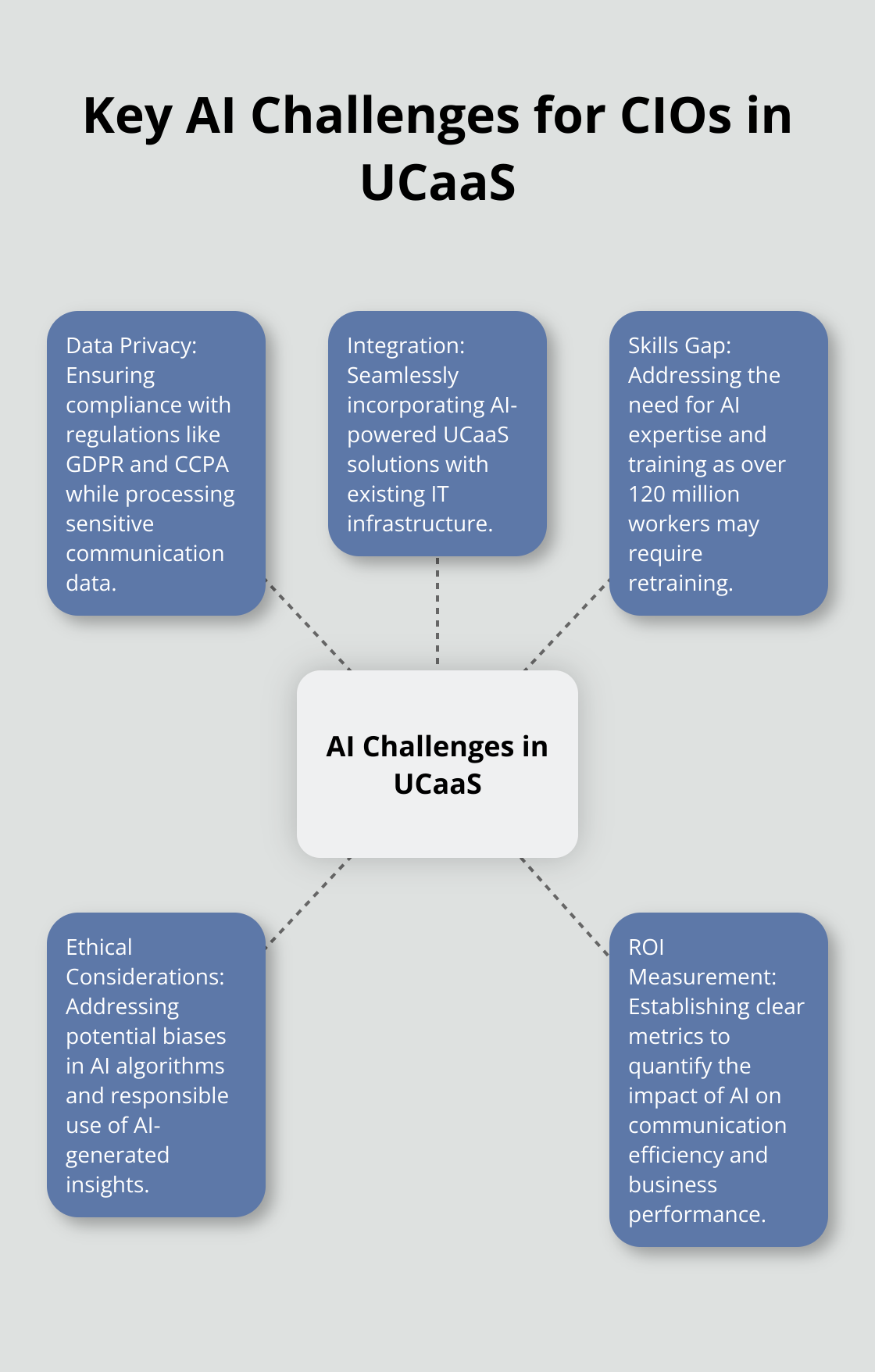AI is no longer a futuristic add-on. It’s becoming the core engine behind how teams connect, respond, and get work done. At UCaaS Review, we’ve seen this shift firsthand as AI reshapes everything from voice quality to workflow automation.
For many CIOs, the turning point came quietly. A team lead asks why their calls still drop during client demos. A customer service agent wonders why notes from last week’s call are missing. These small moments point to a bigger truth. Unified Communications needs to be smarter, faster, and more responsive. AI is how we get there.
This post explores the most meaningful AI innovations in UCaaS today and what they mean for your communication strategy moving forward.
How AI Is Revolutionizing UCaaS
AI transforms UCaaS at an unprecedented pace, offering game-changing capabilities for businesses. Three key areas where AI makes significant strides are natural language processing, predictive analytics, and AI-powered assistants.
Natural Language Processing Enhances Communication
Natural Language Processing (NLP) revolutionizes how we interact with UCaaS systems. AI enhances the efficiency and effectiveness of communications systems by automating tasks, analyzing data, and facilitating more intuitive interactions. This technology enables more natural, context-aware interactions between users and UCaaS platforms.
NLP allows for real-time translation during video calls, breaking down language barriers in global teams. It also powers advanced voice commands, enabling users to schedule meetings or send messages hands-free. CIOs should prioritize UCaaS solutions with robust NLP capabilities to enhance user experience and productivity.
Predictive Analytics Solves Problems Proactively
Predictive analytics is another AI-driven innovation reshaping UCaaS. This technology can predict customer needs and enable businesses to take proactive measures. This improvement translates to significant benefits for organizations.
For CIOs, this means less downtime and improved service quality. Predictive analytics can identify patterns in call quality, network performance, and user behavior, allowing IT teams to address problems proactively. When evaluating UCaaS providers, CIOs should look for those offering robust predictive analytics capabilities.
AI-Powered Virtual Assistants Streamline Workflows
AI-powered virtual assistants and chatbots become indispensable in UCaaS platforms. These tools can handle a wide range of tasks, from scheduling meetings to providing real-time information during calls. Surveyed employers believe that AI could boost productivity by 47%, with large-sized organizations expecting the highest boost (49%).

Some providers are already deploying conversational AI receptionists that handle call routing, voicemail transcription, and CRM integration. PanTerra’s Luna, for instance, combines natural language processing with secure, real-time call handling, allowing businesses to automate front-line communication while maintaining compliance and responsiveness across time zones.
CIOs should consider how these AI assistants can integrate with existing workflows. For example, an AI assistant could automatically transcribe meetings, extract action items, and update project management tools. This level of automation can significantly streamline communication processes and boost overall efficiency.
The Future of AI in UCaaS
As AI continues to evolve, its impact on UCaaS will only grow. CIOs must stay informed about these innovations and strategically implement them to maintain a competitive edge. The goal is not just to adopt AI for its own sake, but to leverage it in ways that genuinely enhance communication and collaboration within organizations.
The next chapter will explore how these AI-driven innovations directly impact UCaaS performance and user experience, providing CIOs with valuable insights for decision-making.
How AI Transforms UCaaS Performance
AI revolutionizes UCaaS performance, delivering tangible benefits for businesses. Significant improvements in call quality, user experience, and security reshape how organizations communicate and collaborate.
Elevating Call Quality and Network Performance
AI algorithms optimize network traffic in real-time, resulting in clearer calls and reduced latency. Cisco’s AI-powered noise cancellation technology reduces background noise by up to 90% (a critical improvement for remote workers in noisy environments).
Network optimization through AI leads to more efficient bandwidth usage. Gartner reports that AI-driven network management can reduce network downtime by up to 50%. This translates to fewer IT tickets related to call quality issues and improved overall user satisfaction for CIOs.
Tailoring User Experiences with AI
Personalization stands as a key feature in modern UCaaS platforms. AI analyzes user behavior to create intuitive interfaces and streamline workflows. Microsoft Teams uses AI to suggest relevant files and contacts during meetings, saving users valuable time.
A study by Accenture found that 75% of employees believe personalized technology increases their productivity. CIOs should prioritize UCaaS solutions that offer AI-driven personalization to boost employee engagement and efficiency.
Fortifying Security with AI-Powered Detection
AI transforms UCaaS security. Advanced algorithms detect unusual patterns and potential threats in real-time. Meeting disruptions and security, and privacy issues, including encryption, remain important concerns for UCaaS providers.
Moreover, AI-driven fraud detection in UCaaS platforms has been shown to reduce fraudulent activities by up to 60%, according to a report by Juniper Research. This level of protection proves essential as cyber threats continue to evolve and target communication systems.

CIOs must prioritize UCaaS providers that leverage AI for robust security measures. Features like AI-powered authentication, anomaly detection, and automated threat response safeguard an organization’s communications effectively.
The impact of AI on UCaaS performance continues to grow. From crystal-clear calls to personalized experiences and enhanced security, AI sets new standards in unified communications. As we explore the challenges and considerations for CIOs in the next section, it becomes clear that understanding and leveraging these AI-driven advancements will be key to successful UCaaS implementation.
Navigating AI Challenges in UCaaS: A CIO’s Guide

Data Privacy: The Cornerstone of AI Implementation
Data privacy remains a top concern when implementing AI in UCaaS. AI systems process vast amounts of sensitive communication data, making compliance with regulations like GDPR and CCPA essential. A recent study found that 86% of respondents noted a positive impact of privacy legislation on their organizations, up from 80% previously.
CIOs must:
- Conduct regular privacy impact assessments
- Implement robust data encryption methods
- Establish clear data retention and deletion policies
- Select UCaaS providers with strong data protection track records
Providers that offer end-to-end encryption and comply with international data protection standards should take priority.
Seamless Integration: Bridging the Old and the New
The integration of AI-powered UCaaS solutions with existing IT infrastructure presents significant challenges. A survey revealed that only 48% of digital initiatives meet or exceed their business outcome targets.
To ensure smooth integration, CIOs should:
- Conduct a thorough audit of existing communication systems
- Develop a phased integration plan
- Invest in APIs and middleware for seamless connectivity
- Prioritize UCaaS solutions with strong integration capabilities
Organizations that adopt a hybrid approach (gradually integrating AI features alongside legacy systems) experience 30% fewer disruptions during the transition.
Addressing the AI Skills Gap
The rapid advancement of AI in UCaaS has created a significant skills gap. A study shows that over 120 million workers are poised to undergo retraining in the next three years as AI reshapes industry demands.
To tackle this challenge, CIOs should:
- Invest in comprehensive AI training programs for IT staff
- Partner with educational institutions to develop AI curricula
- Create internal AI centers of excellence
- Consider hiring AI specialists or consultants
Organizations that invest in AI skills development see a 25% increase in the successful adoption of AI technologies.
Ethical Considerations in AI-Driven UCaaS
The implementation of AI in UCaaS raises ethical questions that CIOs must address. These include potential biases in AI algorithms, the impact on employee privacy, and the responsible use of AI-generated insights.
CIOs should:
- Establish clear ethical guidelines for AI use in communications
- Regularly audit AI systems for bias and fairness
- Ensure transparency in how AI is used within the organization
- Involve employees in discussions about AI implementation and its impact
Measuring ROI and Performance Metrics
Quantifying the return on investment (ROI) for AI in UCaaS can prove challenging. CIOs need to establish clear metrics to measure the impact of AI on communication efficiency, user satisfaction, and overall business performance.
Key areas to focus on include:
- Reduction in communication-related IT tickets
- Improvement in call quality and network performance
- Increase in employee productivity and satisfaction
- Cost savings from automated processes and reduced downtime
Where AI Meets Real-World Communication
AI is reshaping communication from the inside out. Clearer calls, smarter assistants, and stronger security are quickly becoming everyday expectations in UCaaS platforms.
For CIOs, keeping pace means paying attention to how these technologies improve real workflows. The priority is to reduce friction, support responsiveness, and build communication systems that reflect how people actually work.
Emerging features like emotion-aware assistants and adaptive network tools are already making their way into enterprise settings. What makes them valuable is how well they align with day-to-day needs and long-term strategy.
UCaaS Review continues to track these developments and highlight what works. We’re here to help decision-makers find clarity in the noise, with tools and insights designed for real business outcomes. AI is evolving fast. Your strategy should be ready for it.



